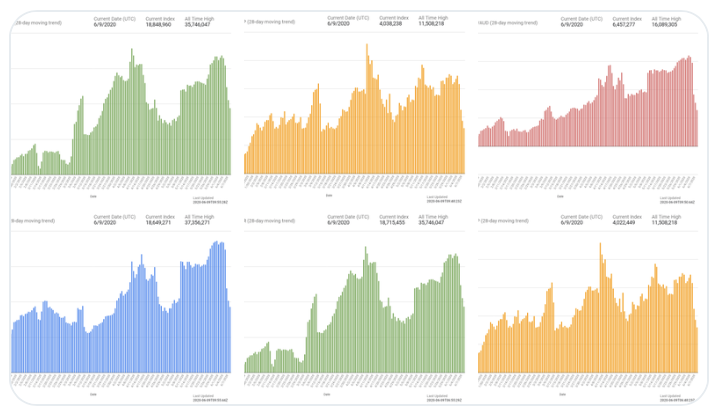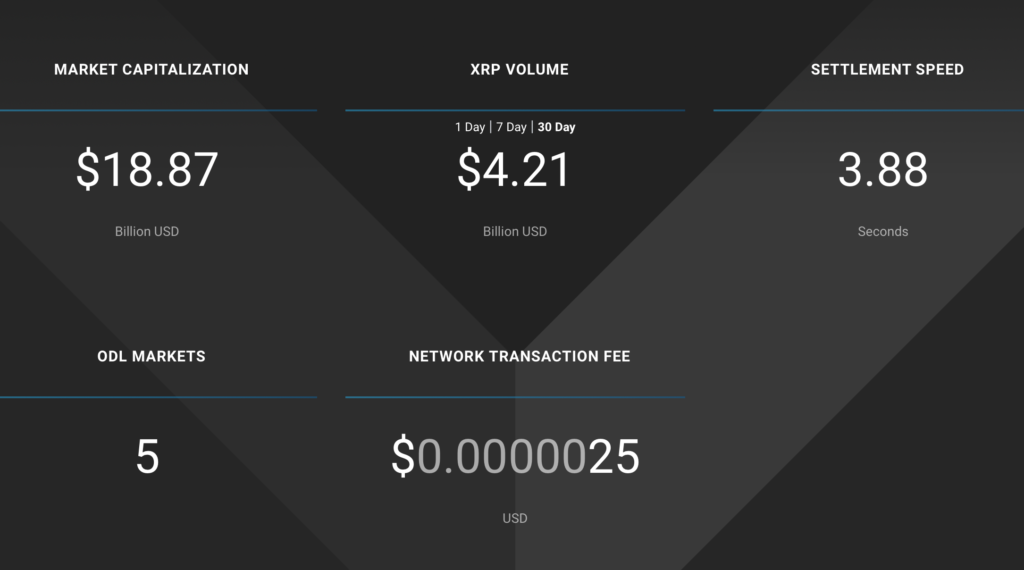XRP Weekly Report June 12, 2020 – Why Ripple’s ODL Reset Is Not a Bad Thing
This weeks’s big question of course is Ripple’s announcement to reduce emphasis on large treasury payments, which – for now – drastically reduces ODL (On-Demand Liquidity) volume. What are they not telling us? Who pulled what plug?
This XRP Weekly, however, is a bit different. Instead of the XRP and Ripple timeline of events, this Weekly focuses first on the June 8 Ripple announcement that caused quite a stir: “Staying the Course in Remittances and SME Payments.”
In the timeline, hear Ripple CEO Brad Garlinghouse talk about the impact of Covid-19 crisis and why he expects overall market dynamics to be good for crypto and good for Ripple. But first things first.
XRP Market Overview
Bitcoin still does its dog and pony show: tricks the market into a sense of recovery, followed by the usual big fat red candle. Sadly, XRP still has no own legs, the token only mimics the king coin’s movements while movement upwards are followed timidly and movements downwards accelleration. No decoupling keeps XRP enslaved. The only way to beat this market is either patience or your’re so good to have a slight majority of trades in the plus.
Ripple’s Bombshell Announcement: “Staying the Course in Remittances and SME Payments”
Now let’s take a look at the Ripple story making waves this week. Key excerpts of the June 8 article written by Asheesh Birla, Ripple Senior Vice President of Product and Corporate Development:
In particular, we are reducing emphasis on large treasury payments -which are traditionally used to fund businesses and services in the absence of real-time transfers – to support individual, low-value transactions, addressing the growing need in remittances and SME payments. This may reduce overall ODL transaction volumes.
Still, because the benefits of ODL are so compelling for enabling the future of global payments, we anticipate businesses will support even more transactions than ever before on RippleNet, and new additional connections on the network will take shape.
At first sight, this seems like a defeat, an admission of failure, forcing Ripple to hit the reset button and setting ODL metrics back by about a year.
The crash in ODL volume is substantial – more than 50 percent within three days. Screenshot taken on June 9:

Yet, Asheesh is quick addresses the outcry in the XRP community and explains on Twitter:
Ripple CTO David Schwartz adds:
Now let’s examine why this whole turn of events might be a good and healthy development, assuring XRP to work the way it’s intended to.
1. Ripple Strikes Against Nostro / Vostro Hijacking ODL
Most likely some of these treasury transactions were just moving nostro / vostro funds using ODL. The whole point of ODL is to eliminate nostro / vostro prefunding and associated risks, or at least mitigate the need to prefund. ODL is about P2P elimination of nostro / vostro.
Ripple putting the breaks on this furthermore means no more quick depletion of order books, but a steady flow of smaller, real-time, direct payments ramping up liquidity. Ripple can now move forward.
2. Force Them to Need You
Big correspondent banks controlling and profiting from nostro / vostro friction are not ready to abandon their most profitable ship. Trying to work with the system and changing it from the inside out proves to be more difficult than anticipated. A few corridors and low liquidity aren’t enticing for banks. Ripple seems to have a hard time getting names and Swift to adopt ODL and XRP, and ISO20022 just got delayed again.
Ripple’s decision to change strategy will entice financial institutions caught in the middle to have a closer look at RippleNet and ODL offerings. While adoption at the top is dragging on, Ripple will concentrate on smaller micro payments. The bigger players will get it together eventually.
For now, Ripple is focusing on the small and medium fish, which are the lower hanging fruits, offering the path of the least resistance and allowing Ripple to scale volume to the degree necessary to eventually feed the big fish. And while those big fish, for now, remain focused on cutting fat and treading water rather than moving to a faster, leaner, safer money transfer network, Ripple gets ready for them.
3. Better Many Small Than Few Large Customers
Ripple does not want to depend on single large clients, but reshape the international cross-border transactions market from ground up. They want to drive the benefits all the way down to the customer – as already emphasized in July 2018 by Dilip Rao, Ripple’s then Global Head, Infrastructure Innovation:
4. Aggressive ODL Expansion
Ripple concludes its announcement with the phrase: “We want to talk.”
If you’re a financial institution interested in learning more about RippleNet’s ODL service and its benefits for eliminating the need for pre-funding, we want to talk.
Reminds me of Ripple’s aggressive camping out in front of Swift’s annual convention back in 2017 in Toronto, trying to lure away heavyweight Sibos attendees to the Ripple’s simultaneously held Swell event.
Ripple is pushing the reset button from a position of strength, not weakness. They have the right product and are just about to start. Asheesh in the announcement goes on to say that Ripple will open more ODL corridors this year and ramp up volume:
Ripple is on track to open new ODL corridors this year and we’re onboarding new customers and working with existing customers to ramp up ODL volume in important corridors including USD-MXN, USD-PHP, AUD-USD and PHP, and from EUR-USD.
Also, Ripple did not say in the statement they won’t do anymore treasury-type transfers in the millions of dollars. They’re just optimizing the system.
5. Western Union, Welcome Aboard ODL?
Western Union is mentioned in the announcement as if this competitor is already using RippleNet. We might have Western Union board ODL sooner than we expect. Ripple publishes this artictle with a clear intention, anticipating the result of negotiations between Western Union and MoneyGram.
No, it’s not Western Union’s attempt to aquire Ripple ODL partner MoneyGram that crashes ODL. Asheesh even confirms: “Yes, MGI continues to be an active ODL customer.”
6. Ripple CEO Reactivates His “Peanut Butter Manifesto”
Seems like Ripple CEO Brad Garlinghouse reactivates the legendary Peanut Butter Manifesto, which dates back to his days at Yahoo. Rather than spreading Ripple’s resources too thinly and not focusing on anything in paticular, Ripple refocuses and resets priorities.
7. Lack of Liquidity Needs to Be Addressed
Not all is sunshine. An obvious lack of XRP liquidity urges Ripple to reprioritize. Ripple might just be backing away from accommodating business cases for larger payment sizes until XRP has more liquidity.
High token inflation and low price certainly don’t help improve liquidity. One might hope Ripple is not to give away XRP as abundantly anymore as in the past. Not only does this send out wrong signals. Tighter supply and rising demand could increase price and thereby improve liquidity.
8. Incentives Don’t Create Organic Uptake
In its current incentivized form ODL does not seem to create organically growing uptake. In other words: how sustainable is growth driven by incentives? Not sustainable.
Ripple likes to refer to the early days of PayPal how they incentivized uptake. In order to create organic growth and demand they have to cut down on those incentives that most likely were funded through XRP sales. Reduced incentive scheme XRP sales will reflect in real-market token demand, price appreciation and increased liquidity.
9. Low-Value, High-Frequency Payments Are Key
If things are still unclear, this should put the controversy once and for all to rest. Ripple is after low-value, high-frequency payments – just as Mastercard and Visa do:
David emphasizes the same points:
10. So… Is the ODL Reset Good or Bad?
More good than not, it seems. Ripple has already proven they can easily transact large cross-border payments. That’s not what they’re after. They’re not particularly keen to handle your large transaction when you buy a house. They want to be the bridge mechanism when you shop, eat, have a drink, buy something online. In everyday life, on a global scale, without friction and no borders.
11. Number of Transactions Matters More Than Volume
We should rather be looking at the number of transactions than volume. Unfortunately, Ripple in January eliminated the TPS (transactions per second) metrics from their site. You can, however, still check TPS on xrpscan.com and livenet.xrpl.org.
TPS are currently maxed out at 1,500 – we’re still far away from this number, currently in the very low double digits. But 1,500 is not carved in stone and can be substantially increased according to Ripple developers. Visa does around 1,700 transactions per second on average.
Trying to change the financial industry vertically is not just smooth sailing and sunny skies. But yes, Ripple’s about-face is a well thought out, ambitious and forward looking step. And I am patient. Ripple will figure it out. If the tech is that much better, it makes it difficult to argue for the benefits of legacy systems.
A Word of Caution
The metrics available still do not show any sign of ODL recovery and we have no way to tell what payments exactly fell off the cliff. If Ripple is serious about the transparency it prides itself, then according tools should be made available, such as TPS metrics (which don’t erroneously spike at the top of the hour as in the past).
There’s this empty spot on Ripple’s Market Performance page. What better use for it than making more reliable TPS appear again, as a reference to ledger activity.

That’s it for the analysis of Ripple’s controversial announcement, over to the Weekly’s timeline.
Ripple Reaches 350 Customers
Navin Gupta, Ripple’s Managing Director in the South Asia and MENA region, in a virtual session published on June 1 updates the number of Ripple customers to “about 350 financial institutions who use our technology every day.”
The aha moment in blockchain technology, Navin says, will occur in about three to five years down the road when companies embrace blockchain.
BTC Markets CEO: “XRP Is Becoming Increasingly Mainstream”
Inexpensive, efficient, safe – cross-border money transfers via XRP are just brilliant, says Caroline Bowler, CEO of Australian Ripple ODL partner BTC Markets. In fact, she mentions the word “brilliant” several times in this Digital Finance Analytics interview published on June 8.
Bowler talks of increasing XRP activity both regarding ODL and trading. What we’re going to see, she says, “it’s becoming increasingly mainstream.”
Ripple’s Craig DeWitt: “Number of XRP Verticals Being Built Are Gonna Multiply”
Thinking Crypto on June 8 interviews Craig DeWitt, Senior Director of Product at Ripple.
Main takeaways:
Even though things are moving slowly, eventually the U.S. gets things right, DeWitt says. It might take time though. No one can time the market, even less so regulation.
He’s amazed about the incredible growth in the past five years at Ripple. “We’re making the world a better place – it’s not an overnight thing because it is so impactful.”
Over the next years, DeWitt expects some really good infrastructure to be built allowing easily made payments. It’s gonna be a lot easier for developers to build payment applications or applications that leverage payments. XRP as a payment mechanism, yes, but the “number of verticals being built on that are gonna multiply.”
MoneyGram Digital Business Reports Triple-Digit Growth in May
Ripple partner MoneyGram achieves a 100 percent year-over-year digital transaction growth in May, the company reports on June 9. This means a significant acceleration from the first quarter of 2020 where the company reported 57% growth.
- MoneyGram Online, the company’s direct to consumer channel, delivered 107 percent year-over-year transaction growth in May, with over 80 percent of transactions completed on a mobile device.
- Digital partnerships, driven by key partners in Asia Pacific and Middle East, accelerated from 67 percent year-over-year transaction growth in April to 92 percent growth in May.
- Account deposit and mobile wallet transactions increased 156 percent in May which is an acceleration from the first quarter where the company reported 80 percent year-over-year transaction growth. Growth has been driven by markets such as the Philippines where sends to mobile wallets have increased over 200 percent compared to the prior year.
Ripple Says XRP Lawsuit Fails to Show CEO Committed Fraud
Ripple has moved to court asking to drop all fraud charges against it on a lawsuit as plaintiff Bradley Sostack has failed to provide details to back its claims, CoinDesk reports on June 9.
Sostack claims Garlinghouse sold 67 million XRP tokens in 2017, which, he alleges, counts as a misrepresentation as it coincides with the time he was also publicly claiming to be “very, very long XRP.”
Ripple calls this statement fraudulent, arguing that just because Garlinghouse sold XRP doesn’t mean he wasn’t still bullish on the token’s prospects: “Selling a portion of one’s XRP holdings does not mean that the seller cannot also be ‘very, very long’ in the same asset as a percentage of his or her own personal balance sheet.”
Hacker Noon Gets Coil-Enabled for Micro-Tipping
CoinDesk on June 10 reports tech publication Hacker Noon has closed a $1 million strategic investment from micropayments firm Coil, the blockchain-agnostic product built on the Interledger protocol and headed by former Ripple CTO Stefan Thomas.
With Coil’s simple Web tag, the integration lets readers pay Hacker Noon writers based on their screen time. Coil advertises memberships starting at $5 per month. Coil’s preferred payout currency? XRP, of course.
Ripple Offers Most Cost-Effective New Payment Service in Japan
FX Coin on June 10 reports Money Tap, which uses RippleNet, is the cheapest and most efficient new payment service solution in Japan which goes to market on June 22. MoneyTap charges members 1.5 percent tax free per transaction, while same-priced competitors add tax.
Japan’s new system for QR payments is called JPQR and supports 18 payment services, including Ripple-powered MoneyTap. JPQR is to become Japan’s new national payment standard.

Brazilian Bank First to Join Ripple’s Cloud Service
Ripple’s first partner in Brazil is also the first to join the company’s cloud services, reports Cointelegraph Brazil on June 10. Says Ripple in a statement:
The use of “cloud-based services,” i.e. services based on storage and control of data entirely in the cloud, have become increasingly common in different industry segments. In the case of financial institutions, cloud services bring benefits such as agility, greater transparency and cost reduction, in addition to enabling digital transformation – something so relevant at this time when the remote prevails over the physical.
Brad Speaks Out: Ripple to Have Over 500 Employees by Year’s End, Positive Outlook for Crypto Market
In a recorded video call employees, released on June 10, Ripple CEO Brad Garlinghouse addresses the difficulties caused by Covid-19 for Ripple. He can’t wait to go back to the office and presents a solid progress report, despite the global downturn.
Key takeaways:
Q1 took Ripple by surprise, no one expected the impact. Regarding the macro-economic outlook for Ripple, record unemployment numbers will be followed by debasement of fiat currencies, Brad says. Decrease in currency value will turn people to “safe haven” assets, like gold back in the day. He expects this to spill over into cryptocurrencies: “We gonna see dynamics which are good for crypto and good for Ripple.”
Given the slowdown in growth, Ripple is “much more thoughtful about hiring.” By year’s end Ripple will have some 515 employees instead of the expected 575, which is still about 60 positions more than now – and almost twice as many as at the end of 2018.
Since this Ripple in-house address was recorded before the recent ODL crash, Brad refers to 190 percent ODL growth from Q4 to Q1 and an 85 percent increase in volume across RippleNet during the same timespan. “We saw some of our big customers, a player in Thailand, go live. That’s driving a lot of volume.”
Expected were 20 new production contracts in Q1, added were 28. With borders and economies opening up again, one might expect Q3 and Q4 to make up for lost opportunities in the first half of the year.
Even though the globally distributed operations continue during lockdown, Brad concludes he can’t wait to go back to work and continue to build the company and Internet of Value. “We are in a really strong position,” he says, “from balance sheet point of view and customer activity on the network.”
Ripple Officially Launches Brazil Operations
With news posted on June 11, Ripple officially launches operations in Brazil to expand its footprint in South America. Ripple already has more than a dozen Brazilian financial institutions and money transfer companies on RippleNet.

That’s it for this issue. Next XRP Weekly is published on June 19, 2020. Stay tuned!
If you like what you read, sending a tip to XRP address rLHzPsX6oXkzU2qL12kHCH8G8cnZv1rBJh tag 3130998845 is most welcome! 🙏
+++ Please get in touch if you’d like to share XRP and Ripple news or related rumors, inputs, insights.